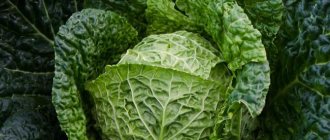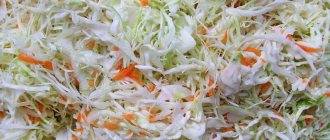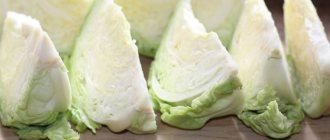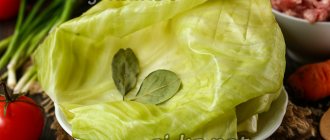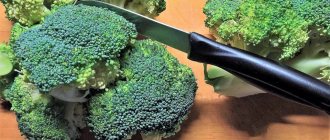White cabbage is a traditional product for our country. This plant grows on almost the entire planet, even on non-black earth lands. There is an opinion that cabbage comes from Russia, although it came to our country from the Mediterranean.
| Calories per 100 g, (kcal): | 27 |
| Protein per 100 g, (g): | 1.8 |
| Fat per 100 g, (g): | 0.1 |
| Carbohydrates per 100 g, (g): | 4.7 |
| Glycemic index: | 15 |
White cabbage beneficial properties
We have known about the medicinal properties of cabbage since early childhood. Vegetable leaves were applied to sore spots, compresses helped to cope with swelling. Cabbage stimulates the production of gastric juice and activates the work of the heart muscle.
Vitamin C has a general strengthening effect. An interesting fact is that the content of this vitamin increases after heat treatment. However, tartronic acid is destroyed after heat treatment, and it is an effective remedy for fat deposits and the appearance of sclerosis.
Folic acid helps normalize metabolic processes; it is especially useful during pregnancy.
Potassium salts allow you to remove excess fluid, so it is recommended to use cabbage if you have kidney problems. Potassium has an expectorant effect, so cabbage helps to cope with colds faster.
When cooked, cabbage strengthens, and when fresh it has a laxative effect.
Of course, the traditional way to get rid of a hangover is sauerkraut.
Broccoli
Due to its low calorie content and beneficial composition, broccoli is used in many diets. It effectively protects blood vessels from damage caused by high concentrations of sugar in the blood.
This type of cabbage contains active substances that have a beneficial effect on the functioning of the heart and nervous system. Broccoli also contains chlorophyll, a component that improves blood composition. Thanks to the large amount of fiber, the plant accumulates and then removes harmful substances and toxins from the body. Coarse fibers promote the evacuation of cholesterol from the intestines.
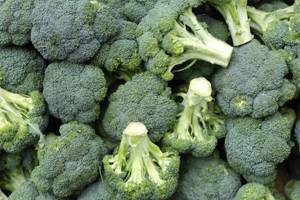
Broccoli contains essential amino acids. Serotonin (or the hormone of happiness) improves mood and helps fight psycho-emotional disorders.
Folic acid, which is found in broccoli, is beneficial for women. It promotes the formation of new cells and resists early aging. Omega-3 fatty acids and beta-carotene remove dangerous cholesterol from the body, normalize blood pressure and improve heart function.
The vegetable contains a lot of calcium, which is necessary to strengthen teeth and bones. Therefore, broccoli is indicated for children, elderly people, pregnant and breastfeeding mothers.
The benefits of cabbage for women
For the weaker half of humanity, cabbage is useful because it has a positive effect on reproductive function, helps speed up metabolism and eliminates inflammation.
Cabbage has a positive effect not only on the gastrointestinal tract, but also improves appearance. Regular consumption of vegetables improves the structure of skin and hair. It helps get rid of swelling and remove harmful toxins from the body.
The vegetable helps strengthen blood vessels, therefore, it is a preventive measure against the development of varicose veins.
Are there any benefits to sauerkraut?
Also check out these articles
- Currant variety Black Pearl
- Araucana chicken breed
- When to sow cabbage for seedlings?
- Drinkers for chickens
Sauerkraut is a frequent guest on the dinner table. Everyone loves it, many dishes are combined with it, and even made from it. But is it useful? Sauerkraut is a very valuable, nutritious product. It contains many vitamins and minerals, but should be consumed in moderation.
This product has a beneficial effect on the functioning of the gastrointestinal tract and endocrine system. It has been noticed that this product slows down the aging process, fat accumulation, and strengthens the immune system. But it has many contraindications. It is not recommended to eat it:
- for gastritis with increased stomach acidity, ulcers, renal failure, urolithiasis;
- during lactation;
- for allergies or individual intolerances.
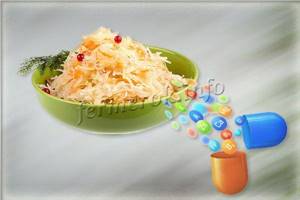
Vitamins in sauerkraut
100 g of product contains approximately 23 kcal. Amount of main substances:
- Fats – 0.1 g;
- Proteins – 1.8 g;
- Carbohydrates – 3 g.
There are a lot of vitamins in sauerkraut:
- Vitamin A – 600 mcg;
- B1 – 0.3 mg;
- B2 – 0.04 mg;
- B5 – 0.2 mg;
- B6 – 0.1 mg;
- B9 – 8.9 mcg;
- C – 38.1 mg;
- E – 0.2 mg;
- H – 0.1 µg;
- PP – 0.9 mg.
Among the minerals it is worth highlighting:
- Chlorine – 1249.2 mg;
- Potassium – 283.4 mg;
- Calcium – 50 mg;
- Sulfur – 34.6 mg;
- Phosphorus – 29.8 mg;
- Sodium – 21.8 mg;
- Magnesium – 16.3 mg;
- Aluminum – 493.7 mcg;
- Boron – 197 mcg.
The composition also contains vanadium, iron, cobalt, lithium, manganese, copper, iodine, nickel, molybdenum, rubidium, zinc, chromium and fluorine. The amount of vitamins and minerals is indicated per 100 g of product.
Interesting!
According to popular belief, it is best to ferment cabbage 5-6 days after the new moon. If you ferment cabbage during the full moon, it will quickly spoil and will not be tasty.
The benefits of cabbage for men
Cabbage is useful for the male body because it contains a large amount of vitamin B 9, which has a positive effect on sperm production. Cabbage is an effective remedy against the development of prostate cancer.
Cabbage relieves sore throat and is recommended for use during regular sports or physical activity. It allows you to fill your body with energy for the whole day.
Thanks to cabbage, men can get rid of diseases of the genitourinary system. The vegetable improves kidney and bladder function. Cabbage strengthens bones and prevents their fragility.
The vegetable allows you to improve the functioning of the nervous system and improve brain activity. With regular use, men can cope with stress more easily and prevent depression. Cabbage has these properties due to the presence of vitamin K and anthocyanin in it.
Vitamins in cauliflower
Cauliflower was known to mankind more than 2.5 thousand years ago. This is an indispensable product for strengthening bones and cartilage. It is recommended for blood diseases, to improve the functioning of the immune system, general cleansing of the body and the walls of blood vessels, among other things. It is contraindicated to use only for gout, allergies, kidney stones and heart failure.
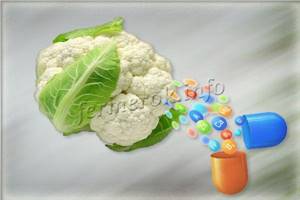
Vitamins in cauliflower
100 g of product contains only 25 kcal. Main substances:
- Fats – 0.28 g;
- Proteins – 1.91 g;
- Carbohydrates – 4.97 g.
What vitamins are in cauliflower, and in what quantities are they present:
- Vitamin A – 3 mcg;
- B1 – 0.1 mg;
- B2 – 0.1 mg;
- B4 – 45.2 mg;
- B5 – 0.9 mg;
- B6 – 0.16 mg;
- B9 – 23 mcg;
- C – 70 mg;
- E – 0.2 mg;
- H – 1.5 µg;
- K – 16 µg;
- PP – 1 mg.
This type of vegetable also contains a lot of minerals:
- Potassium – 299 mg;
- Phosphorus – 44 mg;
- Sodium – 30 mg;
- Calcium – 22 mg;
- Magnesium – 15 mg;
- Iron – 0.42 mg;
There are also selenium, copper, fluorine, zinc and manganese.
Cauliflower is much superior to white cabbage. So nutritionists, first of all, recommend eating it or broccoli. Unfortunately, both of these vegetables are extremely rarely to the taste of children, and not all adults are happy about its presence on the plate. But if you learn how to cook them, you can create real culinary masterpieces. Many housewives, for example, mask the taste of cauliflower, while others improve it through other components of the dish.
Eating cabbage during pregnancy
Doctors strongly recommend including cabbage in the diet of expectant mothers. You can use it in any form. Cabbage will help you get rid of nausea and flatulence. The vegetable gently cleanses the intestines and saturates the body with folic acid.
Regular consumption of cabbage will prevent the occurrence of all kinds of fetal pathologies. It is responsible for the proper development of the nervous system. When sauerkraut is used, it is an excellent preventative against cancer.
In addition, cabbage quickly eliminates the feeling of hunger. And coarse fibers prevent you from gaining excess weight.
What vitamins are in seaweed?
We recommend reading our other articles
- Raspberry variety Golden Domes
- The best varieties of sweet and bitter peppers for greenhouses
- Autoclave Bulat
- The best varieties of columnar cherries
Sea kale is a kelp seaweed suitable for human consumption. This is a very exotic product. But it is very useful, and therefore has recently been popular on sale. Despite the fact that seaweed is usually processed, dried, or other products are added to it before sale, it does not lose its nutritional value.
Important!
The composition of sea kale depends on the light, salinity, and temperature of the sea water in which it grows.
With regular consumption of seaweed, the body is cleansed of radionuclides, cholesterol and other harmful substances. The functioning of the gastrointestinal tract is normalized, the overall weight of the body is reduced. In addition, the immune system is strengthened, brain nutrition is improved, and hormonal levels are normalized.
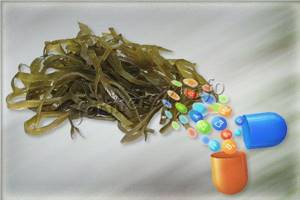
Vitamins in seaweed
Sea kale can be harmful if consumed for:
- allergies;
- diseases of the endocrine system;
- hemorrhagic diathesis;
- acute gastrointestinal diseases.
100 g of seaweed contains 24.9 kcal. Also included:
- Fats – 0.2 g;
- Proteins – 0.9 g;
- Carbohydrates – 3 g.
The vitamin composition indicates the high benefits of this product.
- Vitamin A – 100 mcg;
- B1 – 0.04 mg;
- B2 – 0.06 mg;
- B6 – 0.02 mg;
- B9 – 2.2 mcg;
- C – 1.9 mg;
- PP – 0.5 mg.
There are a lot of minerals in seaweed, the main ones are listed below.
- Potassium – 942.1 mg;
- Chlorine – 573.8 mg;
- Sodium – 505.5 mg;
- Magnesium 165.1 mg;
- Calcium – 42.4 mg;
- Phosphorus – 53.4 mg;
- Iron – 15.6 mg;
You should also mention such important minerals as iodine, sulfur, cobalt, manganese, copper, molybdenum, zinc, which are also present in the composition, but in smaller quantities.
How to take cabbage for medicinal purposes
In the presence of vitamin deficiency and as a prophylactic against the appearance of ulcers, cabbage juice is used. It is recommended to drink the drink for 30 days, half a glass 3 times a day. The juice is also used for decreased secretory function.
If you add a little sugar to the juice, it will be an excellent expectorant and anti-inflammatory agent.
The seeds of the vegetable are used as an anthelmintic.
If there are pathologies of the gallbladder or liver, it is recommended to use sauerkraut brine.
For gout, use fresh cabbage leaves. If wet eczema or scrofula is observed, then the leaves of the vegetable are boiled in milk and mixed with bran. The mixed components are used as compresses.
Raw juice allows you to get rid of stomatitis and warts.
Vitamin salad from white cabbage
There are many recipes for making cabbage salads. The most useful and popular options among athletes and nutritionists are presented to the reader.
Salad “Charge of vivacity”
The components of this salad saturate the body with vitamins, energy and health. Anyone who wants to have a slim figure, healthy skin and a youthful face should definitely add it to their diet. The salad is easy to prepare and everyone can afford it.
Required Products:
- Half a head of fresh cabbage;
- Several sweet and sour apples;
- One large carrot;
- Mayonnaise, sour cream or vegetable oil for dressing;
- A bunch of fresh parsley;
- Freshly squeezed lemon juice;
- Salt and pepper to taste.
Preparation:
- Wash all vegetables thoroughly.
- Finely chop the cabbage, add salt and squeeze lightly with your hands to soften it and release the juice.
- Peel the carrots and grate on a coarse grater.
- Also grate the apple after the carrots. You can remove the skin from it, but when grated it won’t be tough anyway.
- Add chopped parsley to the vegetables.
- Mix all ingredients well with the chosen dressing and sprinkle with lemon juice. Vitamin salad of vigor is ready!
Read: How many kcal are in white cabbage
Video on the topic:
Salad “Vitamin abundance”
Preparing this salad is not difficult and does not take much time. It can be prepared either immediately before serving or for long-term storage (in a closed glass container it can be stored in the refrigerator for a month). The ingredients in this salad contain a lot of vitamins and contain no harmful fats or weighting agents.
Products for cooking:
- Several bell peppers;
- Two heads of red onion;
- One large carrot;
- Paul – a kilogram of fresh cabbage;
- Sunflower oil and vinegar for dressing.
- Salt, sugar.
Preparation:
- Grind the cabbage into thin shavings.
- Wash the pepper, cut into two parts and remove the core. Cut into thin half rings. We also chop the onion.
- Peel and wash the carrots. You can chop it into long strips or grate it using a Korean grater.
- Combine all vegetables, season with oil, vinegar and salt. You can add a little sugar.
- Place the finished salad in a salad bowl or a clean jar to put in the refrigerator.
The use of cabbage in cosmetology
Cabbage in any form is used for cosmetic purposes. For oily skin, prepare a mask according to the following recipe: chop the cabbage, mix the resulting 2 tablespoons of gruel with egg white and apply to the skin of the face. After 30 minutes, wash off the mask with warm water. You can eliminate fat content with sauerkraut juice. Wipe your face with the juice every day, in the morning. Sour cabbage juice helps get rid of freckles and age spots.
If your hair is thin and split, juice from fresh cabbage is mixed with spinach and lemon. The resulting mixture is applied to the scalp and kept for about 20 minutes, then rinsed off with warm water and washed with shampoo.
Useful material
The basis of white cabbage and other types of cabbage is water and fiber.
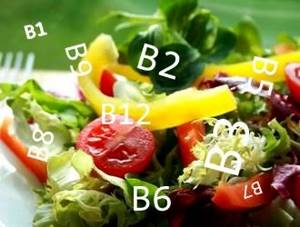
But this is not what makes it indispensable on our table.
This vegetable is completely free of sucrose and starch, but contains large quantities of various types of vitamins, macro- and microelements, as well as fructose and glucose.
This is a storehouse of vital substances that maintain human calm, vigor and health. What is cabbage rich in and what does it contain?
Benefits of cabbage juice
Cabbage juice can be called a kind of vegetable essence. The juice contains all the beneficial substances and vitamins that the vegetable has. From 300 ml of juice, the human body receives as many useful substances as could be obtained from eating 50 kg of vegetables.
Just one glass of juice a day will help you get rid of gastrointestinal diseases. You can enhance the effect of the juice with sorrel, honey and pomegranate juice. In the summer, you can make juice from dandelions and add it to cabbage juice.
But if the acidity is increased or the stomach ulcer has worsened, then it is better to stop drinking juice. You should not drink juice after abdominal surgery.
By the way, they even make kvass from cabbage. This drink has a pronounced effect of normalizing intestinal microflora. That is, it eliminates bloating and improves peristalsis.
Is cabbage harmful?
The product in question can be taken in any form: juice, pickled, fresh, and so on. But there is a category of people whose product is contraindicated. Cabbage will be prohibited if you are treating the following diseases:
- enterocolitis;
- pancreatitis;
- tendency to gas formation;
- increased stomach acidity.
Otherwise, cabbage and the vitamins in it are beneficial for the body. And one moment. Breasts do not grow from eating cabbage, but achieving a wasp waist is quite possible. The main thing is to take a thoughtful approach to planning your diet and don’t forget to exercise.
Cabbage harm and contraindications
Still, if you are trying to lose weight, you should not eat white cabbage every day. It contains a lot of fiber, which injures the walls of the stomach and causes flatulence and bloating.
It is prohibited to consume cabbage during exacerbation of gastric pathologies, with enterocolitis, gastritis, or if bleeding, intestinal or gastric, is present.
Selenium and zinc have a negative effect on thyroid hormones, therefore, you should not overuse the vegetable if you have thyroid pathologies.
What vitamins do white cabbage contain?
The most common and beloved by all is white cabbage. This is the simplest species that is grown by gardeners around the world. It contains a lot of nutrients necessary for the normal functioning of the human body.
Cabbage has anti-inflammatory, healing, cleansing, and antimicrobial properties. It can relieve pain and alleviate throat diseases. However, it is not recommended to eat it fresh if there is increased stomach acidity or bleeding (in the gastrointestinal tract).
Important!
For pancreatitis, gastritis, ulcers, the consumption of white cabbage should be strictly limited! It can cause colic, bloating and many other problems.
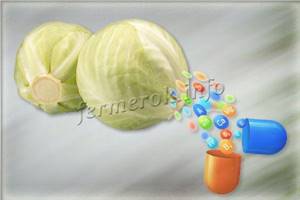
Vitamins in white cabbage
100 g of fresh cabbage contains only 28 kcal. The main substances are:
- Fats – 0.1 g;
- Proteins – 1.8 g;
- Carbohydrates – 4.7 g.
What vitamins are found in large quantities in white cabbage:
- Vitamin A – 3 mcg;
- B1 – 0.03 mg;
- B2 – 0.07 mg;
- B4 – 10.7 mg;
- B6 – 0.1 mg;
- B9 – 22 mcg;
- C – 60 mg;
- E – 0.1 mg;
- K – 76 µg;
- PP – 0.9 mg.
There are also a lot of minerals in this product. The most important ones are listed below.
- Potassium – 300 mg;
- Calcium – 48 mg;
- Phosphorus – 37 mg;
- Chlorine – 37 mg;
- Sulfur – 31 mg;
- Magnesium – 16 mg;
- Sodium – 13 mg;
The amount of vitamins and minerals is indicated in 100 g of fresh white cabbage.
The vitamins and minerals presented above are contained in such quantities exclusively in fresh white cabbage. If it has been thermally processed (especially boiling, frying, stewing), the amount of nutrients in it will be reduced.
How to select and store
The main criterion for choosing high-quality cabbage is the elasticity of the vegetable. There should be no dents or soft areas on it. It is best that there are no yellow spots on the vegetable; the color should be bright green.
Cabbage can be stored for up to 5 months. The vegetable can be stored in the cellar and refrigerator. Under no circumstances should storage in direct sunlight be permitted. It is best to store the heads of cabbage individually, wrapped in paper, in the refrigerator.
Cabbage is a complete product, affordable and healthy. It contains a huge amount of useful substances that are found in the vegetable in a form accessible to the human body.
Vitamins and minerals in 100 grams of cabbage
A distinctive feature is methylmethionine in the composition. This amino acid helps prevent the development of atherosclerosis, reducing cholesterol levels in the blood, and stimulates the production of B4 - choline, a vitamin that accelerates the regeneration of the mucous membrane lining the digestive tract and organs.
The predominant vitamins in cabbage per 100 g:
- Vitamin C (ascorbic acid) - 60 mg - has an antioxidant effect and stimulates the production of hormones responsible for a good mood, has an adsorbing effect, accelerates the absorption of iron from foods;
- Vitamin B4 - 10.7 mg - normalizes the functions of the central and peripheral nervous systems and stabilizes carbohydrate metabolism;
- Vitamin B3 (nicotinic acid) - 0.9 mg - increases the defenses of the human body.
But these are not all the vitamins that cabbage contains. Fresh cabbage contains tocopherol, niacin, riboflafin, thiamine, pyridoxine and phylloquinone. The last nutrient is responsible for blood clotting.
To understand how healthy white cabbage is, you should look at its mineral composition.
The predominant macroelements (per 100 g) are:
- potassium - 300 mg - stabilizes acid-base and water-electrolyte balance, normalizes heart contractions;
- silicon - 53 mg - stimulates the regeneration of bone and cartilage tissue, has an adsorption effect;
- calcium - 48 mg - mineralizes the musculoskeletal system and teeth;
- sulfur and chlorine - 37 mg each - thanks to this substance, the body is protected from the aggressive effects of radiation and ultraviolet radiation, receives bile during meals, and chlorine retains fluid, maintaining skin elasticity;
- phosphorus - 31 mg - distributes energy throughout the body, providing energy throughout the day.
Also sufficient amounts of magnesium and sodium.
The human body also needs microelements no less. Per 100 g predominate:
- manganese - 0.17 mg - improves the properties of synovial fluid and promotes the restoration of cartilage tissue;
- iron - 0.6 mg - prevents the development of anemia and supports the life cycle of red blood cells;
- zinc - 0.4 mg - if this substance is not enough, age-related changes quickly develop.
The composition also contains other trace elements (boron, iodine, cobalt, fluorine, chromium) - 13 items in total.
You can count how many essential and non-essential amino acids there are. The first - 12, with a predominance of arginine and leucine, the second - 8, most of all glutamic and aspartic acids. Glutamic acid has a restorative effect and helps to return to normal after physical activity that causes muscle microtrauma, and aspartic acid normalizes nerve impulse conduction.
But white cabbage occupies one of the leading roles in the human body not only because of its vitamin and mineral properties. It is also tasty; it can be consumed fresh, salted, pickled, or after heat treatment.
Useful tips
How to choose
When choosing cabbage, carefully inspect the head of cabbage. Fresh cabbage gives off a pleasant aroma. It has elastic leaves. There are no black spots, cracks or spots on them and the base of the head of cabbage.
Don't buy cabbage with thick top leaves. It is grown using nitrogen fertilizers (nitrates). The weight of such cabbage is usually lighter than that of cabbage grown without chemical fertilizers.
And one more nuance. Test the ripeness of the cabbage by squeezing the forks with your hands. A ripened head of cabbage is not deformed . This means that the cabbage will be crispy in the salad and will not soften when fermented.
How to store
During storage, it is important to retain moisture in cabbage leaves . To do this, wrap it in cling film and place it in the vegetable drawer of the refrigerator.
Before packaging, it is necessary to check the condition of the upper leaves and stalks. They must be free of damage and signs of rotting.
Note! Cabbage intended for storage should not be wetted.
Video: “The benefits of sauerkraut”
Calories and nutritional value
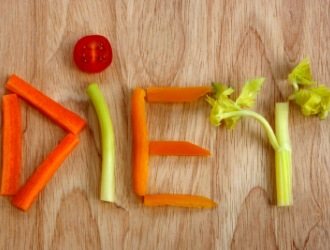
White cabbage is a low-calorie product.
Its calorie content does not exceed 27 kcal per 100 g of finished product.
Therefore, it is widely used in various diets. Salads, cocktails and juices made from it promote effective and rapid weight loss.
However, adding fats and combining them with meat and other vegetables can increase the calorie content of fried and stewed cabbage to 35-150 kcal .
The nutritional value of a product is determined by the amount of proteins, fats, carbohydrates and other vital substances it contains. For cabbage it is 28 g.
